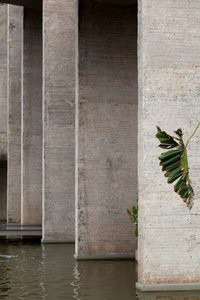Adrien Missika
dal 9/2/2013 al 4/5/2013
Segnalato da
9/2/2013
Adrien Missika
Kunsthaus Glarus, Glarus
A Walk In The Park. His points of reference are generally photography and video, from which the artist sounds out the boundaries of reality and the imagination, the plausibility and construction of those media. In constant search of the perfect 'iconic' image, Adrien Missika travels the world and examines unusual places and phenomena with his camera.

Adrien Missika (b, 1981 in Paris, lives and works between Geneva and Berlin), works in the media of photography, video, sculpture and installation. His points of reference are generally photography and video, from which the artist sounds out the boundaries of reality and the imagination, the plausibility and construction of those media. In constant search of the perfect ‘iconic’ image, Adrien Missika travels the world and examines unusual places and phenomena with his camera.
For his first institutional solo exhibition in the german part of Switzerland, he is developing new works specially for the spaces of Kunsthaus Glarus. To this end he is following the traces of the Brazilian landscape architect and artist Roberto Burle Marx (1909-1994), a designer of gardens, parks and promenades. Apart from numerous designs for public and private gardens and squares, such as the promenade in Copacabana or several public gardens in Brasilia and Sao Paulo Burle Marx also designed six patios for the UNESCO building and sketched the terraces of the Centre Pompidou in Paris (not realized). He is seen as the founder of modern garden architecture, and worked often with the architects Lucio Costa, Le Corbusier and Oscar Niemeyer. His gardens are characterised by curved organic forms, creating the overall impression of an abstract painting. In Brazil, Burle Marx used native plants. A total of 33 species were named after him. He cultivated the tropical plants that he collected on his expeditions and then used them for his gardens. The use of native plants was an innovation in Brazil at the time – until then Brazilian gardens had followed the European model, and European plants were used, gestures of cultural colonialism, but also exotic symbols in the tropical context.
For the skylight room of Kunsthaus Glarus, Missika is using a design featuring plants and sculptural flower-tower constructions. He has transported Burle Marx’s codes of garden design into the museum space, and is transforming the Kunsthaus into a walk-through tropical conservatory. For the construction of the bamboo towers, he is using the Asian knot technique of scaffolding, expanding the architectural space into a vertical dimension. This formal element is often used in compacted city planning as well as utopian concepts of vertical gardens and green cities. In the side-light room he is showing photographs of plants and gardens which are shown on a display system of sculptural elements in the form of metal panels. Missika has adapted this form of presentation from a system used in the botanical department of the Indian Museum in Calcutta. In their function, the elements are hybrid and variable. They serve as autonomous sculptures, as picture supports, as a frame for large format photographs or even as a screen for video works. Further images are projected on discarded window panes from a modern commercial building. With these sculptural elements, autonomous mini-exhibitions are produced within the exhibition space.
Missika collected his extensive pictorial material during a journey through Brazil on the trail of the landscape designer in the manner of a Grand Tour like the ones that travellers took towards the end of the 19th century. He is particularly interested in the legacy of European modernism outside of Europe. He documents the contemporary state of the projects of the landscape architect in Brazil, who are part of the country’s national inheritance, while being at the same time subject to a certain temporariness, instability and disorganisation. He also focuses upon tropical plants and the concept of the conservatory, the European model of cultivation and museification of the exotic and the different. Glazed annexes to grand houses and greenhouses were developed in England in the 18th century, and served both as social meeting points and as exotic presentations of cultural treasures from colonial territories in palm houses and botanical gardens. But they also have a lasting influence on modern architecture, with its glass and steel constructions. Missika is basically concerned with the confrontation between nature and cultural construction, old and new, décor and ‘fake’, and the concept of the ruin, to which Burle Marx himself repeatedly returned.
After he concluded his studies at the Ecole cantonale d’art de Lausanne (ECAL) in 2007, Missika’s work was shown in solo exhibitions at the Coalmine Fotogalerie in Winterthur (2009) and La Rada in Locarno (2010). Several galleries also showed his works in solo exhibitions, such as Blancpain Art Contemporain in Geneva (2010), SpazioA Gallery in Pistoia (2011) and Galerie Crone in Berlin (2012). His works have been shown in group projects including The Beirut Experience Project I and II in Beirut Art Center and Villa Bernasconi in Lancy, the Swiss Art Awards (2011, 2010, 2009), La Jeunesse est un art – Jubiläum Manor Kunstpreis at Aargauer Kunsthaus (2012) and Le Silence. Une Fiction in the Nouveau Musée National de Monaco (2012). In 2011 he was awarded the Prize of the Fondation Ricard and the Kiefer Hablitzel Prize, and in 2009 he received the Swiss Art Award. He has spent residencies in India in the Artst in Lab Programme of NCBS (2011), in Berlin (Atelier Canton de Genève, 2011) and Paris (Atelier Canton Vaud, 2010). In 2011 he received his first monograph in the Pro Helvetia series Cahiers d’Artistes. Missika is also a co-founder of the exhibition space 1m3 in Lausanne.
Image: © Adrien Missika
Tropical Darkness, 2013
Photo: Adrien Missika
Kunsthaus Glarus
Im Volksgarten Postfach 665 CH-8750 Glarus
Hours:
Tuesday to Friday 2pm - 6pm
Saturday and Sunday 11am - 5pm
Easter Monday, Näfelser Fahrt, Landsgemeinde, Ascension Day, Whit Monday and 1 August 11.00 - 17.00
Entrance:
Adults: Fr. 6.-
Reduced: Fr. 4.-



